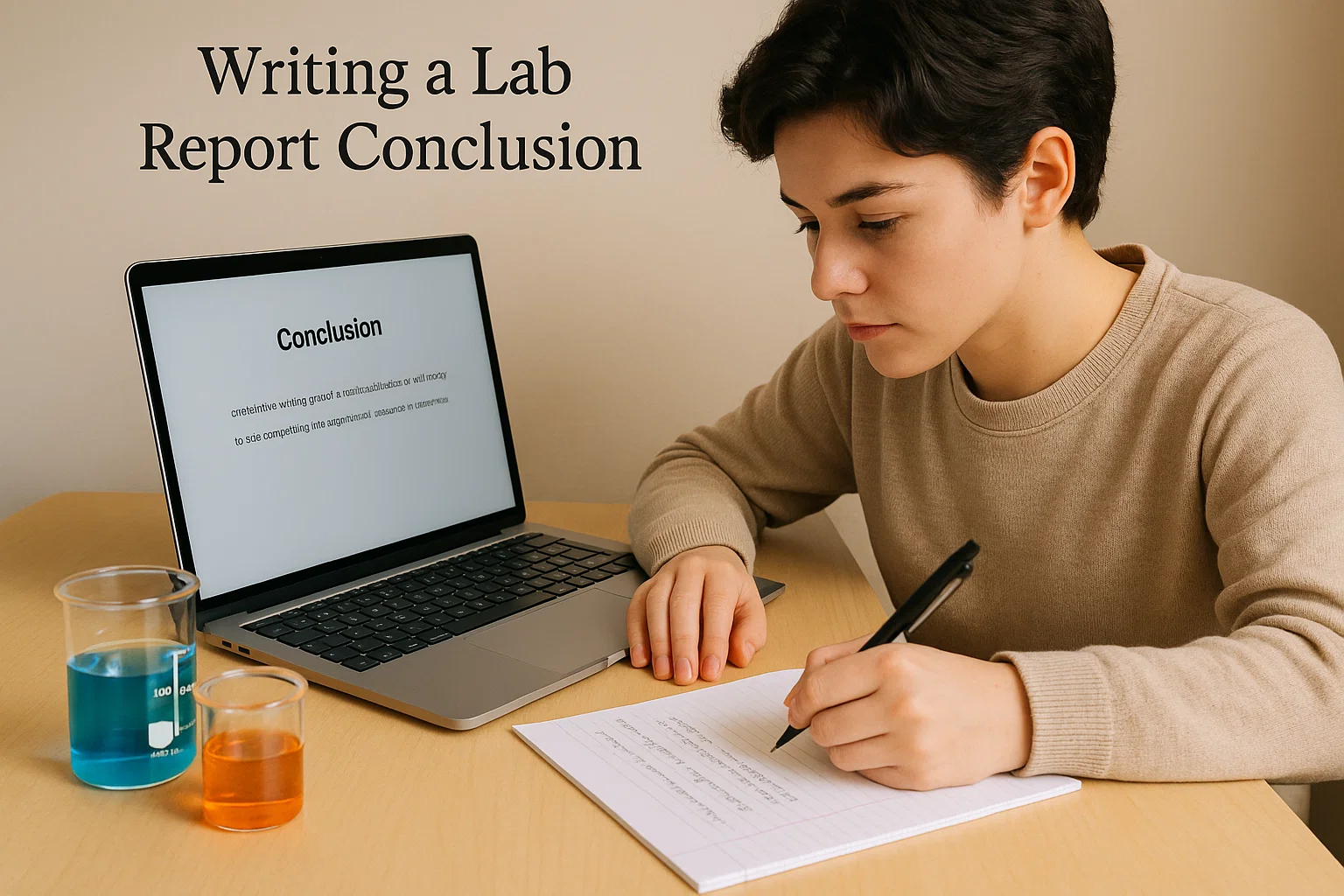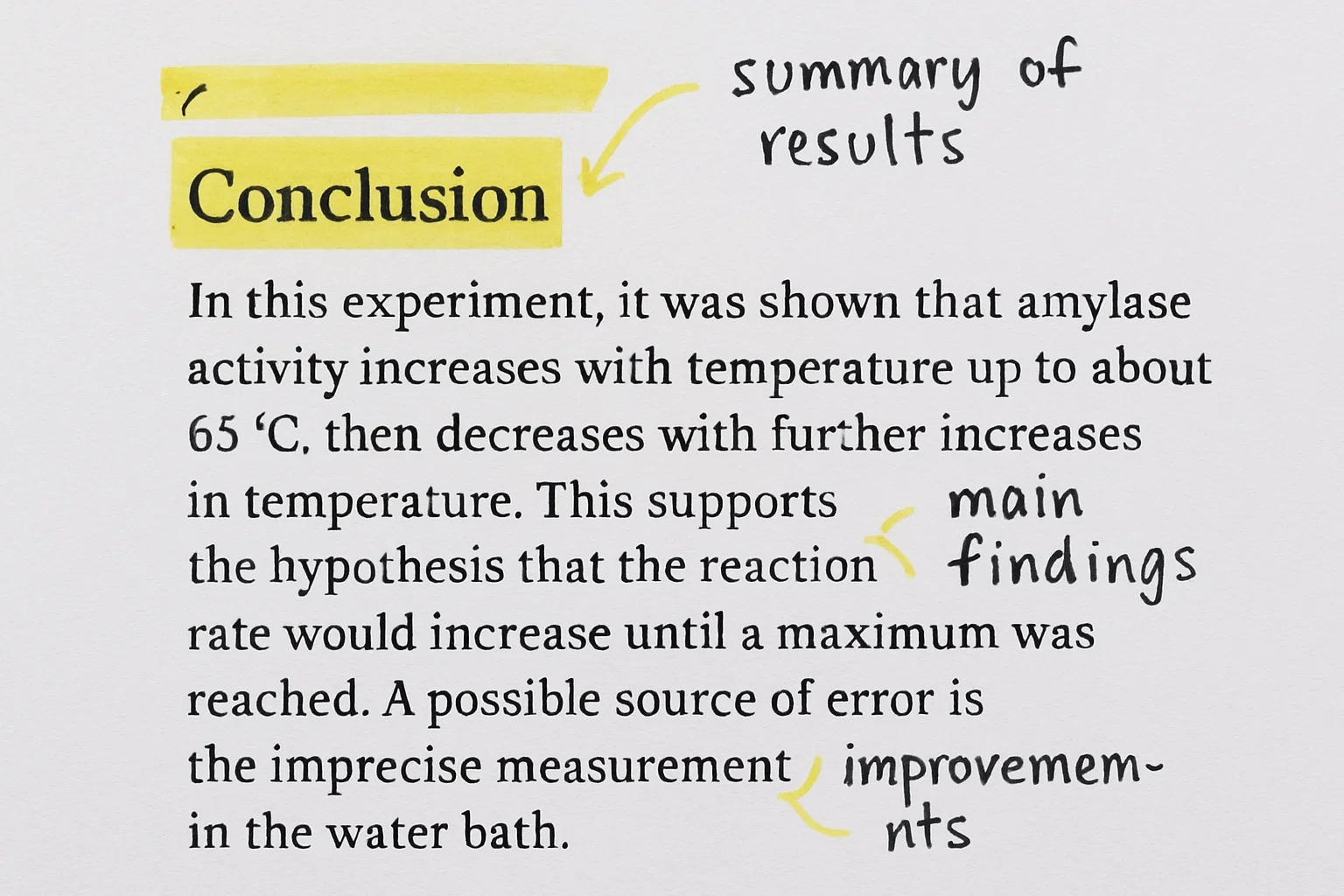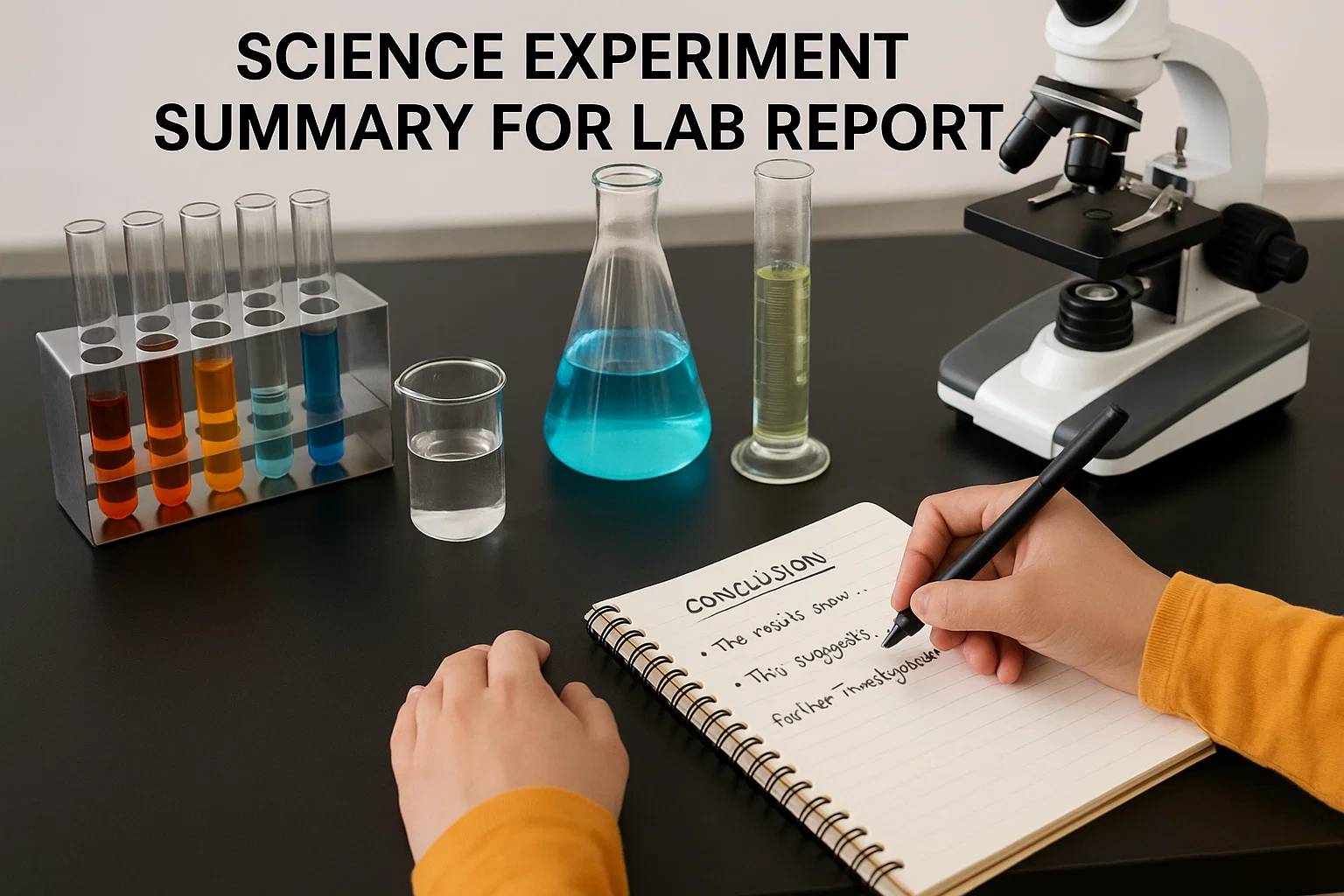You’re not alone. Writing the conclusion of a lab report feels simple on paper, but when it’s time to actually do it, suddenly everything you learned just… evaporates.
Let’s change that.
By the end of this article, you’ll not only know how to write a conclusion in a lab report but also why it matters, what to include, and what to skip. And yes I’ll walk you through a real example too.
Why Your Lab Report Conclusion Actually Matters
Think of the conclusion as the “storyteller” part of your experiment.
All those tables, graphs, and results? The conclusion ties them together into a short, clear narrative.
Here’s the thing a lab report isn’t just about doing the experiment right. It’s about showing you understood what happened and can explain it logically.
That’s why teachers and professors often read the conclusion first. It’s your final chance to say,
“Here’s what I found, why it matters, and what it tells us about the experiment.”
In short:
A great conclusion turns messy data into meaningful insight.
A weak one makes it look like you just copied steps from a textbook.
What Makes a Strong Lab Report Conclusion
Let’s break it down the best conclusions usually have these traits:
- Clarity: It’s short, direct, and easy to understand.
- Connection: It links results back to your experiment’s aim or hypothesis.
- Insight: It doesn’t just restate numbers; it interprets what they mean.
- Confidence: It sounds professional not like a half-guess.
- Reflection: It acknowledges possible errors and suggests improvements.
Imagine your reader didn’t perform the experiment. They should still finish your conclusion and understand exactly what you discovered, why it’s important, and whether your hypothesis held up.
The Simple Structure That Always Works
Most students overthink the format, but you really don’t need to.
A clear, five-part structure does the job beautifully:
- Restate the experiment’s aim or purpose
→ What were you trying to test or find? - Summarise your main findings
→ What did you observe? What do the numbers show? - Interpret the meaning
→ What do your results suggest? Why did they happen? - Relate to your hypothesis
→ Did your prediction turn out to be true or false? - Reflect briefly
→ Any possible errors, improvements, or next steps?
That’s it.
Five steps. Straightforward, logical, and perfect for almost any science lab chemistry, biology, physics, you name it.
How to Write a Lab Report Conclusion (Step-by-Step)
Let’s walk through it like we’re doing this together.
Imagine your experiment was testing how temperature affects the rate of a chemical reaction classic classroom stuff.
Step 1: Restate the Purpose
Start with what you were trying to do.
“The purpose of this experiment was to determine how temperature influences the rate of a chemical reaction.”
See? No fluff, no storytelling. Just clear purpose.
Step 2: Summarise the Results
Now summarise what happened but without dumping all your data here.
“The results showed that as temperature increased, the rate of reaction also increased. This pattern was consistent across all trials.”
Quick and simple. The data speaks through your words, not charts.
Step 3: Interpret the Meaning
Now comes the thinking part why did that happen?
“This suggests that higher temperatures provide more energy for particle collisions, leading to faster reaction rates.”
You’re not rewriting your textbook just interpreting the finding logically.
Step 4: Link Back to the Hypothesis
Tie it all together by confirming (or rejecting) your original hypothesis.
“The hypothesis that higher temperatures accelerate chemical reactions was supported by the data collected.”
It’s professional, factual, and neatly closes the loop.
Step 5: Add Reflection and Future Ideas
Finally, show a little scientific maturity mention any errors or how the experiment could improve.
“Although the experiment supported the hypothesis, minor errors in temperature measurement could have affected accuracy. Future tests could use more precise sensors to reduce variation.”
Perfect.
You’ve just written a conclusion that sounds polished, professional, and well-thought-out in five sentences.
Example of a Lab Report Conclusion (Full Sample)
Let’s put it all together in one smooth example.
Experiment Title: The Effect of Temperature on Enzyme Activity
Aim: To investigate how temperature affects the rate of catalase activity on hydrogen peroxide.
Conclusion Example:
The purpose of this experiment was to examine the effect of temperature on enzyme activity. Results indicated that catalase activity increased with temperature up to 37°C, after which it sharply declined. This pattern supports the hypothesis that enzyme activity rises with temperature until denaturation occurs. Therefore, the hypothesis was partially supported. Minor variations in measurement may have been caused by inconsistent sample preparation. Future experiments could include controlled incubation to ensure uniform enzyme temperature exposure.
It’s short. It’s formal. And it ticks every box purpose, results, meaning, reflection.
What Not to Do in a Lab Report Conclusion
Here’s where a lot of students go wrong and lose easy marks.
Don’t:
- Copy your results section word-for-word.
→ The conclusion isn’t a data dump. - Start with phrases like “In conclusion…” or “To sum up my experiment…”
→ This sounds repetitive and unnecessary. - Add new data or random opinions.
→ Everything should come from the experiment, not imagination. - Write like it’s a story.
→ Keep it scientific not dramatic. - Forget to check grammar and tense.
→ Always use past tense (you already did the experiment).
Instead, stay sharp and formal but not robotic. You’re explaining, not performing.
Why Conclusions Are Often Misunderstood
Funny thing most people think writing a conclusion is about “wrapping up.”
But in science, it’s really about reasoning.
You’re proving that you:
- Understood what you did.
- Understood what it means.
- Can communicate that understanding clearly.
That’s why even a simple experiment like measuring density or testing reaction rates deserves a thoughtful ending. Your conclusion is where raw observation becomes knowledge.
And that’s what science is really about.
Bonus: How to Write a Good Conclusion for Any Report (Not Just Labs)
Okay, let’s say you’re writing a project report or a technical analysis instead.
Here’s the universal structure that works beyond science too:
- Restate your goal or objective.
- Highlight key outcomes.
- Explain their implications or insights.
- Suggest improvements or next steps.
- Close with a confident statement.
Example:
“This report successfully analysed the impact of social media trends on digital engagement. Findings showed that short-form content consistently drives higher reach and retention. Therefore, future campaigns should prioritise short-form storytelling across all platforms.”
See? The structure stays the same only the context changes.
Common Questions Students Ask
Does a lab report have a conclusion?
Yes, absolutely. Every proper lab report includes a conclusion it’s one of the key sections alongside the aim, method, results, and discussion. It’s your scientific closing argument.
What is an example of a conclusion?
A short, fact-based paragraph that summarises the experiment’s outcome and supports or rejects the hypothesis. (Scroll up you already saw a perfect one.)
How to write a conclusion for a lab report example?
Follow the five-step structure: restate → summarise → interpret → connect → reflect.
How to write a good conclusion for a report?
Keep it brief, confident, and logical. Focus on what you discovered and why it matters not just what you did.
Quick Tips to Make Your Conclusion Shine
- Keep it short.
Usually 4–6 sentences max. - Use scientific language.
Terms like increase, decrease, supports, indicates, suggests make your tone sound professional. - Stay objective.
Avoid words like “I think” or “I believe.” Just state the evidence. - Don’t panic about perfection.
A clear and logical answer always beats a fancy, overcomplicated one. - Edit last.
Write your conclusion after finishing everything else. That way you already know what your results say.
The Human Side of Writing Conclusions
Here’s a truth that rarely gets said in science class writing a good conclusion isn’t just about following structure.
It’s about thinking like a scientist.
When you reflect on what happened, notice patterns, and connect them to theory, you’re doing real analysis.
You’re not just summarising you’re reasoning. You’re thinking critically about cause and effect.
So, take your time. Don’t rush the last paragraph because it “feels small.”
That last 10% often shows 90% of your understanding.
Final Polish Before Submission
Before you hit submit, here’s a mini checklist:
✅ Check that you restated your aim clearly.
✅ Confirm you’ve summarised only key results.
✅ Interpret findings logically and factually.
✅ Tie back to your hypothesis.
✅ Mention any limitations or improvements.
✅ Keep tense past and passive.
✅ Proofread for clarity and grammar.
You can even use an AI reword tool like Spinbot if you want to tighten phrasing or remove repetition just make sure your ideas remain your own.
A Little Encouragement Before You Go
Writing your lab conclusion doesn’t need to be intimidating.
You’re not being tested on how fancy you sound you’re being tested on how well you understand what happened.
If you can explain your results clearly to someone who wasn’t in the lab, you’ve nailed it. That’s the real sign of a good conclusion.
And who knows? Maybe next time, you’ll actually look forward to writing that last paragraph.

Rachel combines her technical expertise with a flair for clear, accessible writing. A graduate of the University of Edinburgh, she specializes in creating detailed tech-focused content that educates our readers about the latest in web development and SEO tools at Spinbot blog.


